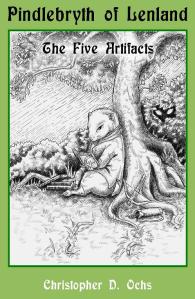By: Christopher D. Ochs
Years ago, I thought I was terribly clever when I started the practice of reading my drafts out loud as part of my editing process. Several writers have since told me that it is a common and highly recommended practice. My blissfully uninformed hubris must also be common in other writers, since I later found myself repressing a snicker at a writer’s conference, as a speaker touted the benefit of reading aloud with all the earnest fervor of Champollion revealing the secret of the Rosetta Stone.
However, despite my previous innocent self-deception, perhaps I actually have added something novel to that process? That being said, if someone has already come up with this practice, I doff my cap to them. Regardless, I still document my process here in the hope it may help and inspire others.
When I read my drafts aloud, I record my voice — in my case, with my Blue Yeti microphone and Sound Forge. Though these are professional grade audio tools, there are several free hardware options and software tools available that will allow you to do very much the same thing — your PC’s built-in microphone with GarageBand for Apple, and Audacity for Windows, to name just a few alternatives.
Once I start the recorder, I only use the mouse to scroll the pages as I read. I force myself not to touch the keyboard during the reading.
I read as emotionally flat as possible, speaking slowly enough that each syllable is enunciated clearly. I cannot stress that enough! If you read aloud at what you feel is a comfortable pace, you will easily misread the material as written. The danger you face here is saying what you think is written, not what actually is in the draft. You have undoubtedly observed this for yourself, if you have read along when someone else reads aloud. I can’t begin to count the number of times I’ve heard readers speaking at their comfortable pace unwittingly substitute, add, drop or switch the order of the written words, or worst of all gloss over actual errors in the draft. Slow down!
I allow myself to interrupt the recording to pepper the verbal flow with not only error corrections, but also with editorial commentary. For example, after a sentence I might say: “choose a better word”, “that just scans bad”, “sounds awkward”, “split up this run-on”, “it’s there, not their”, etc. Quite often, I would stop in a middle of a paragraph and leave myself the audio equivalent of a post-it note: “check if this is consistent with what happened in Chapter X”, “this gives me an idea – add XYZ to the next chapter’s outline”, for example.
If the material is long enough, I take a break after an hour of recording. After fetching a fresh cup of joe, I play back the audio file, reading the written copy along with my recording.
Then — and only then — do I edit the draft text according to the verbal notes I made in the recording. Of course, I pause the playback when the edits become extensive.
I have found this process to greatly enhance the simple step of reading drafts aloud, because it engages several parts of the brain simultaneously – reading, speaking, and listening. When all three language centers are actively engaged, a synergy occurs illuminating all sorts of errors and inconsistencies that otherwise are missed. I can attest to this, because each and every step of this process has helped me uncover additional errors in my drafts, especially during the final step of reading along as I listen to my recorded voice.
Christopher D. Ochs
Animator – Author – Composer – Voice Talent
The Five Artifacts were gifts from the Quickening Spirit to the first five nations of the world: Arctic Fox, Crow, Lemming, Raccoon and Snow Goose. Lost to Time, the Artifacts became the stuff of legend as more animal nations learned the power of language and the tools of civilization.Pindlebryth, Prince of Lenland, awakens to discover the people of his entire nation have been enslaved by a forgotten enemy. He soon learns it is all but a part of a larger plot by an unknown nemesis to use the mystical Artifacts to remake the entire world in their own image.
Pindlebryth, and Lenland’s untried sorceress Darothien, struggle against betrayal, international intrigue, and an unseen puppetmaster, as they race to follow a bewildering trail of ancient clues to locate the most powerful of the Artifacts.
Only to realize its darkest latent power may doom them both.




Have to admit, reading aloud has made a big difference in catching mistakes and missing words. The brain is quite adept at filling in missing words unless it has to go through a voice filter. I know some authors who use “Text Aloud” to read for them. Thanks, Chris. Great article
LikeLike
The best (or worst) part of reading my own stuff aloud is when I realize, “Egad, this is damn dull!” Great article, Chris.
Yes, I actually say “egad.” To myself, of course.
LikeLike